The Glass Fibre Yarn Market is estimated to be valued at USD 9.1 billion in 2025 and is projected to reach USD 15.9 billion by 2035, registering a compound annual growth rate (CAGR) of 5.8% over the forecast period.
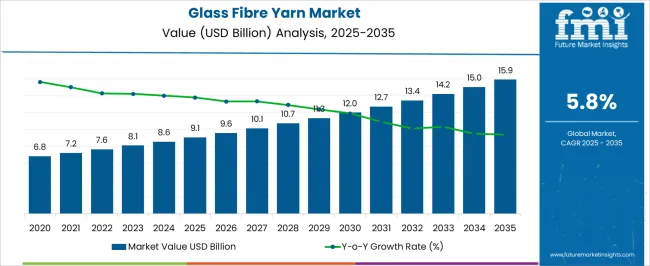
| Metric | Value |
|---|---|
| Glass Fibre Yarn Market Estimated Value in (2025 E) | USD 9.1 billion |
| Glass Fibre Yarn Market Forecast Value in (2035 F) | USD 15.9 billion |
| Forecast CAGR (2025 to 2035) | 5.8% |
The Glass Fibre Yarn market is witnessing steady growth, driven by its critical applications across construction, electronics, and industrial sectors. The current market environment reflects increasing demand for lightweight, high-strength, and thermally stable materials that can replace conventional fibers in various industrial applications. The adoption of glass fiber yarns has been accelerated by ongoing infrastructure development, modernization of printed circuit board manufacturing, and the need for durable composite materials in construction.
Rising awareness of the environmental benefits of lightweight and recyclable materials is further influencing market expansion. In addition, technological advancements in yarn production processes, including improvements in tensile strength, uniformity, and surface treatment, are contributing to enhanced performance characteristics.
The market outlook remains positive as industries seek cost-effective and high-performance alternatives for structural reinforcement, insulation, and electronic applications As demand for high-performance composites continues to rise, Glass Fibre Yarn is positioned to remain a preferred choice for industries requiring long-term durability and lightweight solutions.
The glass fibre yarn market is segmented by product type, application, end-use industry, and geographic regions. By product type, glass fibre yarn market is divided into Single Yarns, Multi-End Yarn, Coated Glass Yarn, and Textile Glass Yarn. In terms of application, glass fibre yarn market is classified into Printed Circuit Board, Glass Fibre Wall Coverings, Electrical And Thermal Insulation, and Grinding Wheel Reinforcements.
Based on end-use industry, glass fibre yarn market is segmented into Construction Industry, Aerospace Industry, Automotive Industry, and Electrical Industry. Regionally, the glass fibre yarn industry is classified into North America, Latin America, Western Europe, Eastern Europe, Balkan & Baltic Countries, Russia & Belarus, Central Asia, East Asia, South Asia & Pacific, and the Middle East & Africa.
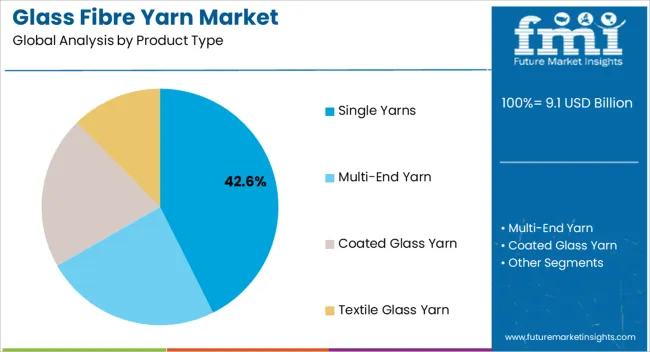
The Single Yarns product type is projected to account for 42.60% of the Glass Fibre Yarn market revenue in 2025, making it the leading segment. The growth of this segment is being driven by its versatility and ease of integration into various composite materials. Single yarns offer superior tensile strength, consistent diameter, and flexibility, which make them ideal for weaving into fabrics and reinforcing polymer matrices.
Adoption has been particularly strong in applications where precise fiber alignment is critical, allowing manufacturers to achieve high-quality end products. The ability to process single yarns into different constructions without significant modification to equipment has supported rapid industrial uptake.
Furthermore, improvements in coating and sizing techniques have enhanced the compatibility of single yarns with resins and polymers, improving performance in structural and electronic applications The combination of durability, adaptability, and cost efficiency has made the Single Yarns segment the preferred choice for manufacturers seeking reliable reinforcement fibers.
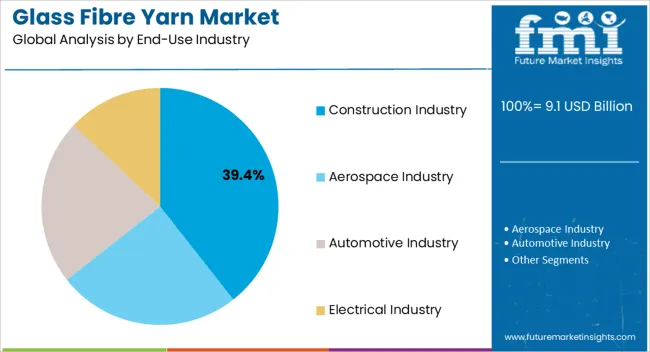
The Printed Circuit Board application segment is expected to capture 45.10% of the total Glass Fibre Yarn market revenue in 2025, establishing it as the leading application area. This segment growth is being fueled by the increasing demand for high-performance, compact, and durable electronic components. Glass fibre yarns are essential in PCB manufacturing as they provide excellent dimensional stability, thermal resistance, and mechanical strength, all of which are critical for modern electronics.
The use of glass fibre yarns improves signal integrity and minimizes warping or deformation during high-temperature processing, enhancing overall product reliability. Growth in consumer electronics, automotive electronics, and industrial automation has intensified the need for consistent and high-quality yarn materials.
Additionally, the scalability of production and compatibility with automated PCB fabrication systems have reinforced the adoption of glass fibre yarns in this segment As electronics continue to evolve toward miniaturization and higher performance, the Printed Circuit Board application segment is anticipated to maintain strong demand for high-quality glass fibre yarns.
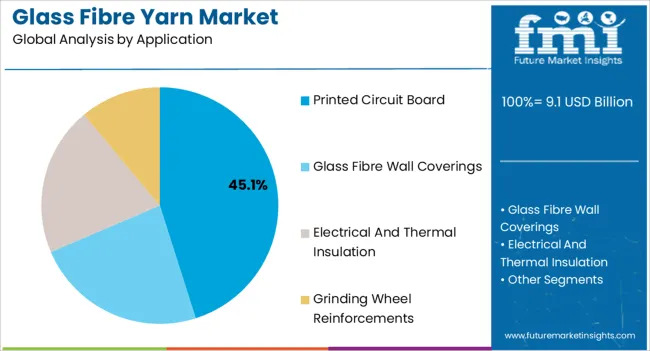
The Construction Industry end-use segment is projected to hold 39.40% of the Glass Fibre Yarn market revenue in 2025, making it the largest consumer segment. This growth is being driven by the rising need for durable, lightweight, and cost-effective reinforcement materials in concrete, composites, and insulation applications. Glass fibre yarns are increasingly preferred due to their high tensile strength, corrosion resistance, and ability to enhance structural integrity without significantly increasing material weight.
Adoption has been particularly strong in infrastructure projects, commercial and residential buildings, and prefabricated construction components where long-term durability is critical. The ability to integrate glass fibre yarns into composite panels, reinforcing fabrics, and coatings has provided architects and engineers with versatile design options.
Additionally, the focus on sustainable construction practices and reducing carbon footprints has reinforced the preference for glass fibre yarns over traditional steel reinforcements As urbanization and large-scale infrastructure development continue globally, the Construction Industry segment is expected to sustain its leadership in market consumption, driven by both performance requirements and cost efficiency.
Glass fibre yarn is produced by the twisting of the basic strands formed from several hundred filaments of glass fibres of the same diameter. The yarn can be twisted in two directions: either a Z-twist or an S-twist. Glass fibre yarn has various advantages over other yarns, which include low thermal conductivity, fire resistance, better electrical & thermal insulation properties and higher specific resistance as compared to steel. In addition, glass fibre yarn can also provide good dimensional stability, electrical resistance and heat resistance.
Glass fibre yarn is made of different types of glass fibre, and every type has its own special properties. For instance, S-glass fibre has good mechanical properties. C-glass fibre is also known as chemical glass because of its good resistance to chemical impact. E-glass fibre is mostly used because it is a good insulator of electricity, owing to which it is also known as electrical glass.
Furthermore, glass fibre is an inorganic fibre, because of which it is completely incombustible, corrosion resistant and heat resistant. Glass fibre yarn has several advantages over PVC yarn, aluminium yarn, etc., because of which it is used in several industries such as aerospace, electrical, automotive, construction, etc.

| Country | CAGR |
|---|---|
| China | 7.8% |
| India | 7.3% |
| Germany | 6.7% |
| France | 6.1% |
| UK | 5.5% |
| USA | 4.9% |
| Brazil | 4.4% |
The Glass Fibre Yarn Market is expected to register a CAGR of 5.8% during the forecast period, exhibiting varied country level momentum. China leads with the highest CAGR of 7.8%, followed by India at 7.3%. Developed markets such as Germany, France, and the UK continue to expand steadily, while the USA is likely to grow at consistent rates.
Brazil posts the lowest CAGR at 4.4%, yet still underscores a broadly positive trajectory for the global Glass Fibre Yarn Market. In 2024, Germany held a dominant revenue in the Western Europe market and is expected to grow with a CAGR of 6.7%.
The USA Glass Fibre Yarn Market is estimated to be valued at USD 3.1 billion in 2025 and is anticipated to reach a valuation of USD 5.0 billion by 2035. Sales are projected to rise at a CAGR of 4.9% over the forecast period between 2025 and 2035. While Japan and South Korea markets are estimated to be valued at USD 428.2 million and USD 276.7 million respectively in 2025.
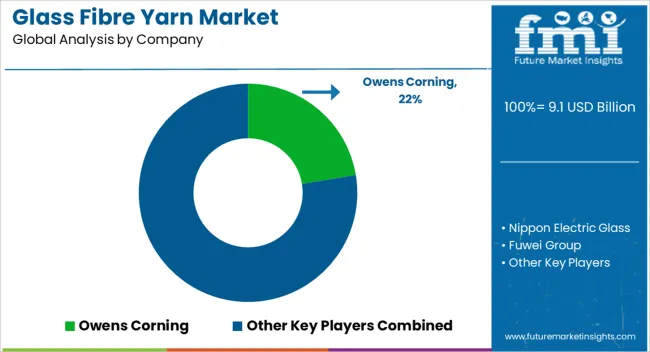
| Item | Value |
|---|---|
| Quantitative Units | USD 9.1 Billion |
| Product Type | Single Yarns, Multi-End Yarn, Coated Glass Yarn, and Textile Glass Yarn |
| Application | Printed Circuit Board, Glass Fibre Wall Coverings, Electrical And Thermal Insulation, and Grinding Wheel Reinforcements |
| End-Use Industry | Construction Industry, Aerospace Industry, Automotive Industry, and Electrical Industry |
| Regions Covered | North America, Europe, Asia-Pacific, Latin America, Middle East & Africa |
| Country Covered | United States, Canada, Germany, France, United Kingdom, China, Japan, India, Brazil, South Africa |
| Key Companies Profiled | Owens Corning, Nippon Electric Glass, Fuwei Group, Jushi Group, Shinsung T, SaintGobain, Isocorp, Vetrotex SaintGobain, Toray Industries, and Hexcel |
The global glass fibre yarn market is estimated to be valued at USD 9.1 billion in 2025.
The market size for the glass fibre yarn market is projected to reach USD 15.9 billion by 2035.
The glass fibre yarn market is expected to grow at a 5.8% CAGR between 2025 and 2035.
The key product types in glass fibre yarn market are single yarns, multi-end yarn, coated glass yarn and textile glass yarn.
In terms of application, printed circuit board segment to command 45.1% share in the glass fibre yarn market in 2025.






Our Research Products

The "Full Research Suite" delivers actionable market intel, deep dives on markets or technologies, so clients act faster, cut risk, and unlock growth.

The Leaderboard benchmarks and ranks top vendors, classifying them as Established Leaders, Leading Challengers, or Disruptors & Challengers.

Locates where complements amplify value and substitutes erode it, forecasting net impact by horizon

We deliver granular, decision-grade intel: market sizing, 5-year forecasts, pricing, adoption, usage, revenue, and operational KPIs—plus competitor tracking, regulation, and value chains—across 60 countries broadly.

Spot the shifts before they hit your P&L. We track inflection points, adoption curves, pricing moves, and ecosystem plays to show where demand is heading, why it is changing, and what to do next across high-growth markets and disruptive tech

Real-time reads of user behavior. We track shifting priorities, perceptions of today’s and next-gen services, and provider experience, then pace how fast tech moves from trial to adoption, blending buyer, consumer, and channel inputs with social signals (#WhySwitch, #UX).

Partner with our analyst team to build a custom report designed around your business priorities. From analysing market trends to assessing competitors or crafting bespoke datasets, we tailor insights to your needs.
Supplier Intelligence
Discovery & Profiling
Capacity & Footprint
Performance & Risk
Compliance & Governance
Commercial Readiness
Who Supplies Whom
Scorecards & Shortlists
Playbooks & Docs
Category Intelligence
Definition & Scope
Demand & Use Cases
Cost Drivers
Market Structure
Supply Chain Map
Trade & Policy
Operating Norms
Deliverables
Buyer Intelligence
Account Basics
Spend & Scope
Procurement Model
Vendor Requirements
Terms & Policies
Entry Strategy
Pain Points & Triggers
Outputs
Pricing Analysis
Benchmarks
Trends
Should-Cost
Indexation
Landed Cost
Commercial Terms
Deliverables
Brand Analysis
Positioning & Value Prop
Share & Presence
Customer Evidence
Go-to-Market
Digital & Reputation
Compliance & Trust
KPIs & Gaps
Outputs
Full Research Suite comprises of:
Market outlook & trends analysis
Interviews & case studies
Strategic recommendations
Vendor profiles & capabilities analysis
5-year forecasts
8 regions and 60+ country-level data splits
Market segment data splits
12 months of continuous data updates
DELIVERED AS:
PDF EXCEL ONLINE
Glass Rolling Forming Machine Market Size and Share Forecast Outlook 2025 to 2035
Glass Liquor Bottle Market Size and Share Forecast Outlook 2025 to 2035
Glass Bottles Market Forecast and Outlook 2025 to 2035
Glass Laser Engraving Machine Market Size and Share Forecast Outlook 2025 to 2035
Glass Restoration Kit Market Size and Share Forecast Outlook 2025 to 2035
Glass Bottle and Container Market Forecast and Outlook 2025 to 2035
Glass Additive Market Forecast and Outlook 2025 to 2035
Glass Reactor Market Size and Share Forecast Outlook 2025 to 2035
Glass Cosmetic Bottle Market Size and Share Forecast Outlook 2025 to 2035
Glass & Metal Cleaner Market Size and Share Forecast Outlook 2025 to 2035
Glass Product Market Size and Share Forecast Outlook 2025 to 2035
Glassine Paper Market Size and Share Forecast Outlook 2025 to 2035
Glass Container Market Size and Share Forecast Outlook 2025 to 2035
Glass Cloth Electrical Insulation Tape Market Size and Share Forecast Outlook 2025 to 2035
Glass Bonding Adhesive Market Size and Share Forecast Outlook 2025 to 2035
Glass Mat Thermoplastic Market Size and Share Forecast Outlook 2025 to 2035
Glass Table Bacteria Tank Market Size and Share Forecast Outlook 2025 to 2035
Glassine Paper Industry Analysis in Western Europe Size and Share Forecast Outlook 2025 to 2035
Glassine Paper Industry Analysis in Korea Size and Share Forecast Outlook 2025 to 2035
Glassine Paper Industry Analysis in Japan Size and Share Forecast Outlook 2025 to 2035

Thank you!
You will receive an email from our Business Development Manager. Please be sure to check your SPAM/JUNK folder too.
Chat With
MaRIA